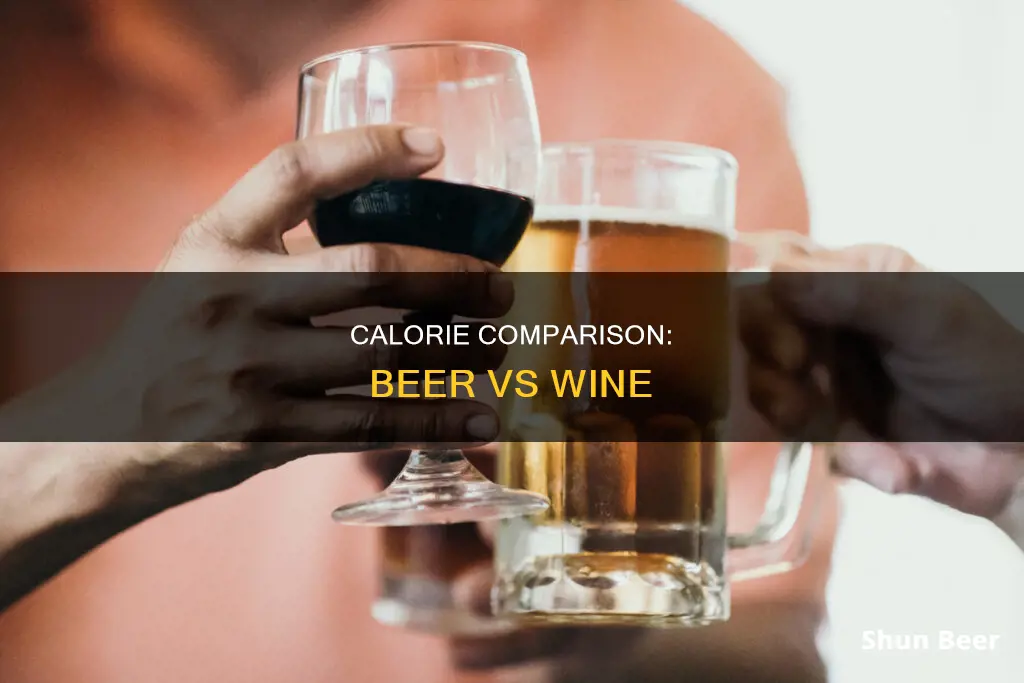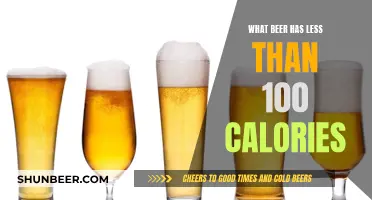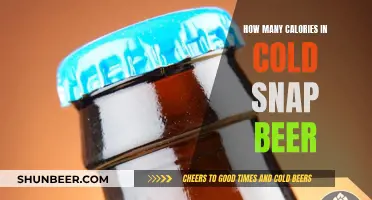
Beer and wine are two of the most popular alcoholic drinks, differing in flavour, ingredients, and nutritional value. While the calorie content of beer and wine varies depending on their type, brand, and ingredients, beer is generally believed to have more calories than wine. A pint of 5% ABV beer is estimated to contain 239-240 calories, whereas a small glass of 12% ABV wine is estimated to contain 133 calories. However, the difference in calorie content between beer and wine is not significant enough to make a clear distinction regarding weight gain.
What You'll Learn

Beer has more calories than wine
Beer and wine are two of the most popular alcoholic drinks, and they differ in flavour, ingredients, and nutritional value. While both drinks have their own unique health benefits, beer is often associated with a higher calorie count, giving rise to the term "beer belly".
Calorie Content
On average, a pint of beer has 50% more calories than a small glass of wine. According to the NHS, a 5% ABV pint of beer contains approximately 240 calories, while a 12% ABV 175ml glass of wine contains about 133 calories. This difference in calorie content is due to the leftover carbohydrates found in beer, whereas wine typically has a lower sugar content.
Alcohol Content
The calorie difference between beer and wine can be attributed to their varying alcohol percentages. Wines with higher alcohol content tend to have more calories than those with lower alcohol content. For example, a 15% ABV wine will have a higher calorie count than an 8.5% ABV wine. However, it's important to note that the type of drink also plays a role, as some beers and wines will naturally have higher alcohol percentages.
Health Considerations
While beer has more calories, it is not necessarily the case that it will cause weight gain. A review of studies found that neither wine nor beer drinkers tend to gain weight in the short term. Additionally, when consumed in moderation, both drinks offer health benefits. Red wine, for instance, contains resveratrol, a chemical compound that may provide long-term cardiovascular benefits and potentially help with cancer prevention. Beer, on the other hand, is a significant source of dietary silicon, which improves bone density and reduces the risk of osteoporosis.
Lower-Calorie Options
If you're looking to cut down on calories, there are lower-calorie options available for both beer and wine. Lighter beers tend to have fewer calories due to their lower alcohol and ingredient density. Similarly, wines with lower alcohol content, such as sparkling wines, will generally have fewer calories. However, it's important to remember that the total calorie intake can vary depending on the brand, type, and serving size.
Best Low-Calorie Beers: UK Edition
You may want to see also

Calorie content depends on alcohol percentage
The calorie content of beer and wine depends on a variety of factors, including alcohol percentage, ingredients, and volume. Generally, a pint of beer has a higher calorie count than a small glass of wine. However, when comparing darker beers and heavier wines, the calorie difference becomes less significant.
Beer is typically made using grains and yeast, and its calorie content can vary depending on the type of beer. Lighter-coloured beers tend to have a lower calorie content than darker beers. This is because lighter beers have a lower alcohol content and lower ingredient density. For example, most light beers have between 60 and 120 calories, while dark beers can range from 100 to 300 calories. The carbohydrate content of beer is also worth considering, as it can contribute to weight gain.
Wine, on the other hand, is made with fermented grapes, and its calorie content depends on the alcohol content and ingredient density. Red wines are made by including the skin of the grapes during fermentation, resulting in a slightly higher calorie count than white wines. On average, red wines have 25 calories per ounce, while white wines have 24 calories per ounce. However, the type and colour of wine can significantly impact the calorie content. For example, rosé wine typically has 70-80 calories per 100ml, while white wine has 73-83 calories per 100ml, and red wine can range from 75-85 calories per 100ml.
According to the NHS, a standard 175ml glass of 12% ABV wine contains approximately 133 calories, while a pint of 5% ABV beer contains around 240 calories. However, these values can vary widely depending on the specific drink. For instance, a Napa Cabernet Sauvignon with 15% ABV will have a higher calorie count than a German Kabinett Riesling with 8.5% ABV.
When it comes to weight gain, consuming too many empty calories and carbohydrates from alcoholic drinks can be a contributing factor. While a recent review of studies concluded that neither wine nor beer drinkers tend to gain weight in the short term, longer-term studies may show different results. Additionally, alcohol is fat-free, but it can still lead to weight gain due to the high calorie content.
Oktoberfest Beer Calories: How Many in One?
You may want to see also

Beer has more carbohydrates
Beer and wine are two of the most popular alcoholic beverages, and they differ in flavour, ingredients, and nutritional value. While the calorie difference between beer and wine is often negligible, beer does tend to have a higher calorie content. This is largely due to its carbohydrate content.
Beer is made using grains and yeast, and the calorie content varies depending on the type of beer. Lighter beers tend to have fewer calories than darker beers. This is because lighter beers have a lower alcohol content and ingredient density. For example, most light beers have between 60 and 120 calories, while dark beers have between 100 and 300 calories. The USDA National Nutrient Database estimates that a regular beer contains about 12.6 grams of carbohydrates per can. Therefore, if you're looking to cut down on carbs, beer may not be the best choice.
On average, a pint of 5% ABV beer contains around 240 calories. The NHS estimates that drinking 5 pints of lager each week adds up to 44,200kcal over a year, equivalent to eating 221 doughnuts!
Wine, on the other hand, typically has a lower sugar content and fewer carbohydrates. Wine is made with fermented grapes, and the calorie content varies based on alcohol content and ingredient density. Red wine is made by including the skin of the grapes during fermentation, while white wine does not, resulting in its lighter colour. Both red and white wines have similar calorie counts, ranging from 120 to 210 calories per six-ounce glass.
While the calorie difference between beer and wine may not be significant, it's important to remember that alcoholic drinks are a source of empty calories, providing no essential nutrients like healthy protein, fat, or fibre. Therefore, consuming large amounts of alcohol can hinder weight loss goals.
In terms of overall health, red wine is often touted for its cardiovascular benefits due to the presence of resveratrol, a chemical compound that may also help with cancer prevention. Beer, on the other hand, is a significant source of dietary silicon, which improves bone density and reduces the risk of osteoporosis.
When it comes to weight loss and overall health, moderation is key. The U.S. Department of Agriculture's Dietary Guidelines for Americans recommends no more than one drink per day for women or two drinks per day for men.
Calories in Carlton Cold Beer: Nutritional Breakdown
You may want to see also

Wine has more sugar
While beer and wine have distinct differences in flavour, ingredients, and nutritional value, it is challenging to determine which has more calories as it depends on several factors. These include alcohol percentage, ingredient density, and the type of drink. For example, darker beers tend to have more calories than lighter beers, and the same goes for wine.
However, wine has more sugar. Wine, which is made with fermented grapes, has between 120 and 210 calories per six-ounce glass. Red wines have 25 calories per ounce, while white wines have 24 calories per ounce. This means that, per 750ml bottle, red wine has 632 calories, and white wine has 607.
On the other hand, beer is made using grains and yeast, and the calorie content varies depending on the type of beer. Most light beers have between 60 and 120 calories, while dark beers have between 100 and 300 calories. On average, a pint of 5% ABV beer contains around 240 calories.
While the calorie difference between beer and wine is not significant, wine has a lower carbohydrate count than beer. However, wine sometimes makes up for this in sugar content. Alcoholic drinks, in general, can hinder weight loss goals when consumed in large amounts due to the empty calories they provide.
Rickards Red Beer: Calorie Count and Nutrition Facts
You may want to see also

Calories don't tell the whole story
While it's true that beer tends to have more calories than wine, this doesn't tell the whole story. The calorie difference between beer and wine can be explained by the leftover carbohydrates found in beer. Wine, by comparison, typically has a relatively low sugar content.
However, before we get too excited about the health benefits of wine, it's important to remember that the total calorie count of alcoholic drinks can vary widely depending on their alcohol percentage. So, a 15% ABV wine will have a higher calorie count than a German Kabinett Riesling at 8.5% ABV.
Another point to consider is that alcohol is fermented sugar, and there is a direct relationship between the amount of alcohol and the number of calories. So, if you're watching your weight, a drink with a lower alcohol content is a good choice.
But calories aren't everything. Both beer and wine have added health benefits that distilled alcoholic drinks do not. For example, red wine is high in tannin, which includes procyanidins that protect against heart disease. Beer, on the other hand, is a significant source of dietary silicon, which improves bone density and reduces the risk of osteoporosis.
So, while it's true that beer tends to have more calories than wine, there are other factors to consider when choosing between the two. The type of drink, the alcohol content, and the health benefits all play a role in the overall impact on your health. Not to mention, overindulging in any alcoholic beverage can lead to weight gain and other negative health consequences.
Calories in Beer: Understanding the Nutritional Breakdown
You may want to see also
Frequently asked questions
A pint of 5% ABV beer contains around 240 calories.
A 175ml glass of 12% ABV wine contains around 133 calories.
Beer has 50% more energy content than a small glass of wine. However, a 2015 review of studies found that neither wine nor beer drinkers tend to gain weight in the short term.







